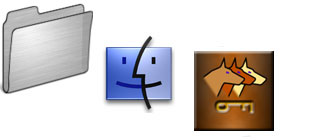 ![[Header]](../XuShared2/Line3.jpeg)

(Up to OJB's Mac Tips List Page)
Finder PreferencesYou can make your experience with macOS (or Mac OS X or OS X) easier by changing the Finder Preferences. These are accessed through the Settings (or Preferences for systems before Ventura) command in the Finder menu when the Finder is at the front.
Of course, different users will prefer different settings, because they prefer to work in different ways, and have different priorities, but my settings do have some merit, so you might find these ideas useful.
I don't show anything on my desktop. Many people find this disconcerting! I prefer to leave the desktop completely clear, except for occasional temporary files. As I work, I drop files onto the desktop, but then file them away to permanent locations, or trash them if they are unnecessary, when I have some spare time, at least once per day.
Disks, etc, which normally appear on the Desktop can be found in the sidebar of any Finder window (choose "Show Sidebar" from the "View" menu if it isn't already on). I do tend to leave display of external disks and server volumes on, just to remind me that they are there.
I usually make new Finder windows open at the computer level but most users should open at the home level instead. I usually work in list view, with name, date modified, size, and iCloud status displayed. I use tags to classify files, usually with tags like "Private Projects", or "Work Consulting", or "Information". And use group by tag, so that the files that belong together get grouped.
Icon view can be useful in some circumstances. In folders which contain a lot of photos, I usually use icon view with the size set (use View, Show View Options, then drag the "icon size" slider to the size you prefer) to something quite big, like 120 pixels. That way I can see the photos as an icon, and the Finder window is like a photo album.
Sometimes column view can also be useful. I tend to use it when I am navigating up and down deep folder hierarchies, especially when I am working in the more technical areas of the computer folder structure, like web sites, Unix directories, like /bin, etc.
The option to "Always show file extension" is useful. File extensions are something that traditional Mac users don't like but they are useful and can make interaction with other computers and with the Internet easier.
Finally, the hidden command to show invisible files can be useful (type command shift dot). This toggles the display of invisible files on and off. Because some folder have a lot of invisible files (my home folder has about 30 of them) I usually have this off to avoid confusion and clutter.
![[Up]](../XuShared/Up2B.jpeg)
|

![[Up]](../XuShared/Up2B.jpeg)